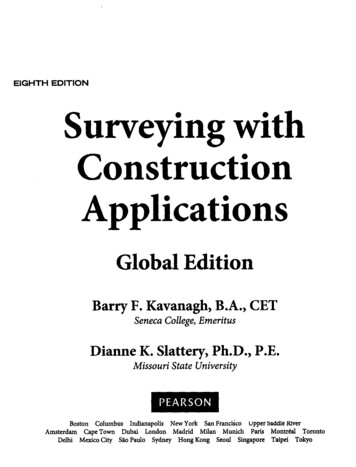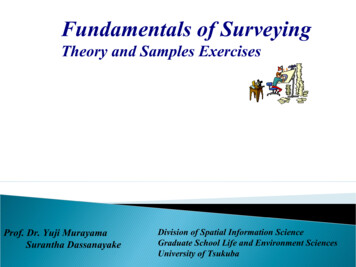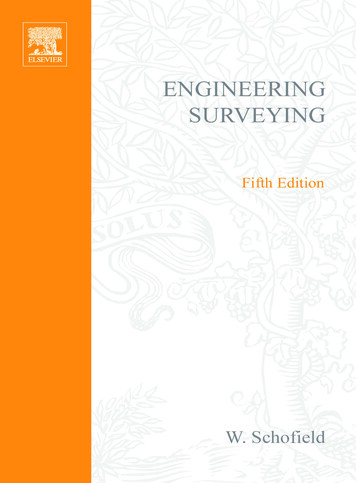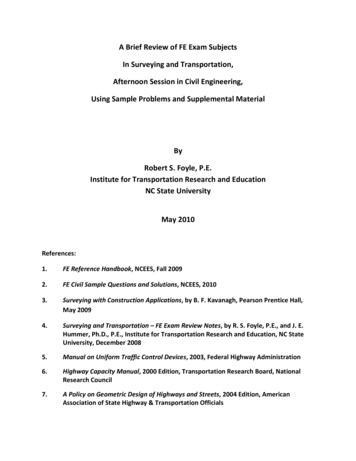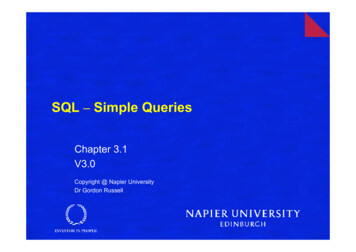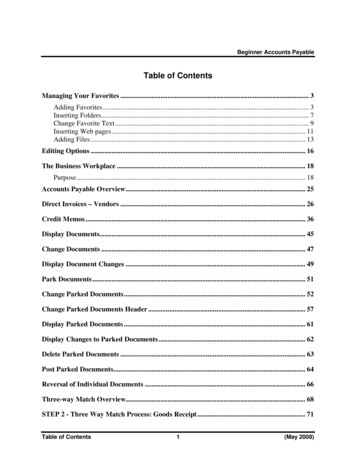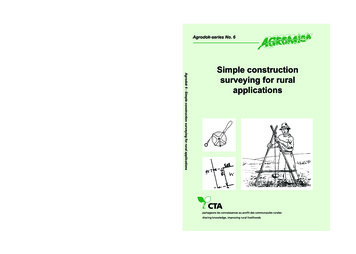
Transcription
Agrodok-series No. 6The AGRODOK-SERIES is a series of low-priced, practical manuals on small-scale and sustainableagriculture in the tropics. AGRODOK booklets are available in English (E), French (F), Portuguese (P) andSpanish (S). Agrodok publications can be ordered from AGROMISA or CTA.Pig keeping in the tropicsSoil fertility managementPreservation of fruit and vegetablesSmall-scale chicken productionFruit growing in the tropicsSimple construction surveying for rural applicationsGoat keeping in the tropicsPreparation and use of compostThe home garden in the tropicsCultivation of soya and other legumesErosion control in the tropicsPreservation of fish and meatWater harvesting and soil moisture retentionDairy cattle husbandrySmall-scale freshwater fish farmingAgroforestryCultivation of tomatoProtection of stored cereal grains and pulsesPropagating and planting treesBack-yard rabbit keeping in the tropicsOn-farm fish cultureSmall-scale production of weaning foodsProtected cultivationUrban agricultureGranariesMarketing for small-scale producersEstablishing and managing water points for village livestockIdentification of crop damagePesticides: compounds, use and hazardsNon-chemical crop protectionStorage of tropical agricultural productsBeekeeping in the tropicsDuck keeping in the tropicsHatching eggs by hens or in an incubatorDonkeys for transport and tillagePreparation of dairy productsSmall-scale seed productionStarting a cooperativeNon-timber forest productsSmall-scale mushroom cultivationSmall-scale mushroom cultivation – 2Bee productsRainwater harvesting for domestic useEthnoveterinary medicineMitigating the effects of HIV/AIDS in small-scale farmingZoonosesSnail farmingThe Rural Finance Landscape 2005 Agromisa FoundationISBN: 90-77073-59-0P, F, ES, P, F, EP, F, ES, P, F, EP, F, EP, F, EP, F, ES, P, F, ES, P, F, EP, F, ES, P, F, EP, F, EP, F, EP, F, EP, F, EP, F, EP, F, EP, F, EP, F, EP, F, EP, F, EP, F, EP, F, EP, F, EP, F, EP, F, EP, F, EP, F, EP, F, EP, F, ES, P, F, EP, F, EP, F, ES, P, F, EP, F, EP, F, EP, F, ES, P, F, EP, F, EP, F, EP, F, EP, F, EP, F, EP, F, EP, F, EP, F, EP, F, EP, F, EAgrodok 6 - Simple construction surveying for rural ple constructionsurveying for ruralapplications
Agrodok 6Simple constructionsurveying for ruralapplicationsJan H. Loedeman
Agromisa Foundation, Wageningen, 2005.All rights reserved. No part of this book may be reproduced in any form, by print, photocopy,microfilm or any other means, without written permission from the publisher.Second edition: 2005Author: Jan H. LoedemanPrinted by: Digigrafi, Wageningen, the NetherlandsISBN: 90-77073-59-0NUGI: 835
ForewordIn autumn 1996 Agromisa asked me to act as a mediator in finding aqualified author for revision of the first version of this booklet, published in 1990. The request meant an open invitation because I feltchallenged to include some of my own ideas about the kind of surveying a new edition of Agrodok 6 should address. As usual, a pertinentdifference manifested itself between the inception of an idea and itsrealisation. Several sources of inspiration kept me going.The unflagging encouragement I have continually received fromAgromisa’s publications manager Marg Leijdens and her successor,Margriet Berkhout, has been decisive. I’m grateful for their unrelenting confidence. I tender my thanks to Johan Boesjes, president ofGITC bv, who financially enabled the proof-reading of my texts.Without the instantaneous dedication of Kate Ashton this would neverhave succeeded in time. Kate also served as my voluntary referencereader. She assured me that this Agrodok makes surveying open to thenon-professional. Being a non-surveyor by profession myself, I wasgreatly relieved when my colleague and friend Marc Chieves –licensed surveyor in the USA and currently editor of The AmericanSurveyor– assured me that my treatise on the subject was sound. Theone-liner with which he communicated his opinion to me will not beeasily forgotten.A vital source of inspiration for this booklet dates back to 1972, to mystay in the Khroumir region of Northwest Tunisia. There I had to swallow some hard lessons from subsistence farmers. As I lived amongstthem for five months they gradually made me understand that important aspects of subsistence farming practices do not lend themselves tomeasurement in the most literal sense. Nevertheless, they showed a lotof interest in the surveying instrument I used to assess the size of theirfields in hectares, a quantity that they didn’t need at all. In their turn,these illiterate but skilled and clever men gradually grasped the intellectual power of measurements in combination with models and calculations. The realisation of this booklet is a humble tribute to them andto their current colleagues elsewhere.Foreword3
Contents1Introduction: scope & structure522.12.22.32.42.5Construction surveying comprises more than meremappingWhat ‘construction surveying’ is aboutSurveying a siteRequirements for a site mapSetting out a construction on a siteDealing with errors and mistakes991217222833.13.23.33.43.53.63.7Surveying methods and techniquesRealising lengths and angles in two planesMaterialising geometric elementsMeasuring length along a line (‘chaining’)Applying square (90 ) horizontal anglesDealing with non-square horizontal anglesApplying square (90 ) vertical anglesDealing with slope angles383845535765697444.14.24.34.4Levelling with an instrumentConceptsEquipmentLevelling methodsError prevention and levelling accuracy79798190995Good surveying practices, a summary103Further reading107Useful addresses109Glossary1104Simple construction surveying for rural applications
1Introduction: scope & structureThe majority of farmers in the world still practise some form of subsistence farming. Their draught-animal and handwork-based farmingpractices, however, cannot be compared with the completely mechanised and highly automated precision-farming practices that are becoming the norm for many of their North American colleagues.Hence, ‘farming’ is a term too general to be explanatory.The same may be said of the term ‘surveying’. A modern surveyorcannot anymore do without a digital computer, which he needs toswiftly perform complex mathematical operations on measurementdata he acquires with sophisticated and highly automated equipment.The same technology enables an earth-moving machine automaticallyto dig a canal or to terrace a slope, according to the spatial form thathas been geometrically designed in a computer and transferred to themachine’s navigation and operating system. But like all farming, surveying too is based on some generic concepts independent of thetechnology used to put these into practice.For whom Agrodok 6 is (not) meantThis booklet is written for those who have an interest, for whateverreason, in measurement techniques related to ‘construction & building’ that go beyond the ones a carpenter applies. He or she is supposedto have at least some idea of basic geometric principles. Though factual knowledge of the branch of mathematics called ‘plane geometry’is not a prerequisite, it will ease the grasping of most subjects presented.This booklet is definitely not written as a manual to satisfy those whoexpect or need detailed instructions, presented in cookbook style.Though some ‘recipes’ are included where this is appropriate or clarifying, too much is left open to the imagination of the reader to makethis book a comprehensive surveying manual. It is neither meant asthat, nor as an aid for drilling surveyors. The purpose is to help peopleto understand some basic principles that lie at the heart of surveying ingeneral.Introduction: scope & structure5
What Agrodok 6 is (not) aboutThis booklet presents surveying in a way it is not practised by anysingle professional surveyor. This sounds both cryptic and unrealistic,but the opposite is true. Getting to grips with surveying is not so mucha matter of learning what a surveyor does, but of what he thinks. Historically, surveying has been characterised by a high degree of labourspecialisation. This is reflected in the tasks surveyors perform and theeducation they receive at various professional levels.In large construction works those who have received the lowest levelof education perform most measurements. Some basic and crucialconcepts need not to be explained or known at this level because,within the context of labour distribution, these concepts are addressedat a higher level in the organisation, at which the surveying process ismonitored. Many textbooks that deal specifically with ‘simple’ surveying techniques may therefore be of little help in providing an overview of these concepts and that process. On the other hand, at thehigher level of education, surveying is dealt with from a mathematicalstarting point. At this level too methods and techniques are presentedand discussed one by one, without surveying being explicitly addressed, from head to tail, as a process.A more generic problem related to any introductory presentation ofsurveying lies in the linking of two quite different ‘worlds’. What thesurveyor is doing, for instance at a construction-site, is clearly visibleand not very different from what the carpenter and the builder are doing there: he takes measures with a device. These actions form the‘real world’ aspect of surveying. The connection between individualmeasurements and the cohesion of a surveyor’s actions rely on an abstract world that obeys the laws of geometry and other branches ofmathematics.Geometric models are at the heart of all surveying. Generic surveyingproblems and their solutions therefore require a transition from thereal world (wherein the measurements take place) to the abstractworld of geometric models (wherein acquired measurement data areactually used and mutually related). The results of mathematical operations have to be migrated back to the real world again, either on thesite or on a piece of paper. From a practical point of view, surveying is6Simple construction surveying for rural applications
actually to a large extent a matter of on-the-job training. In consequence, the distinction between the real world and the abstract worldbecomes easily blurred.This booklet has been conceived as an attempt to present surveying ina generic form by applying geometric concepts without using mathematics. Though abstractions are deliberately not shunned, the presented line of thought is definitely a practical one. Construction surveying offers a very practical context within which to illustrate whatsurveying is about. The qualification ‘simple’ has been included in thetitle to express the idea that the technological level of measurementtechniques presented is ‘intelligible’ and ‘understandable’. This qualification certainly does not imply an ‘unsophisticated’ or ‘naive’ approach to underlying surveying concepts.What Agrodok 6 contains and how it is structuredThe best way to learn surveying is to be trained and drilled on the jobby a professional surveyor. Surveying is like riding a horse or a camel:one will never get to grips with it by merely studying a book about thesubject. And, as with so may crafts, it needs a lot of practice. Moreover, some pitfalls and hurdles cannot be addressed on paper at all,like the reconnaissance of a construction-site that needs to be surveyed. Other aspects that require practice are, for instance, keepingclear and tidy field notes, and the level of detail that has to be provided by the survey in relation to a specific construction.Chapter 2 discusses what comprises construction surveying (Sec. 2.1).The principal aim of construction surveying is to realise a constructionat a site, not merely to make maps (Sec. 2.2). In some instances, however, a site map may be helpful in the design and construction processif it meets certain specific requirements (Sec. 2.3). Setting out a construction at a site implies an inversion of the mapping process, forwhich the same survey techniques are used (Sec. 2.4). The possibilityfor errors lurks in every phase of a survey; prevention and timely detection are at the basis of ‘good surveying practices’ (Sec. 2.5).Introduction: scope & structure7
Chapter 3 begins with clarifying how in a surveying process realworld space is connected to some artificial mathematical space. Ourreal-world space is split up into two ‘flat’ spaces: horizontal vertical.In real space, two sorts of geometric quantities are measured: lengthsbetween positions and angles between directions. These quantitiesmust be geometrically related to the artificial mathematical space. Andinversely, geometric quantities must be literally realised at a site before a construction can be built (Sec. 3.1). Points and lines have to bematerialised, either temporarily or permanently, on a construction site(Sec. 3.2). Devices are used to measure lengths between positionsalong survey lines (Sec. 3.3). Square and non-square angles are usedto realise directions both horizontally (Sec. 3.4 & 3.5) and vertically(Sec. 3.6 & 3.7).Chapter 4 addresses accurate measurement of height differences (vertical lengths) over large horizontal lengths, which requires the use of alevelling instrument. Very limited space available for this chaptermeans that all that can be presented are the concepts of levelling (Sec.4.1) and a description of common equipment (Sec. 4.2). There is noroom to address applications. Methods are presented in a rather briefmanner (Sec. 4.3), followed by tips regarding error prevention (Sec.4.4).Chapter 5, in two pages presents a summary of ‘good surveying practices’ as related to the methods and techniques presented in chapters 2,3 & 4. It is the only part of the book demonstrating a clear cookbookstyle.The glossary included after Chapter 5 comprises a description of m
Simple construction surveying for rural applications 6 What Agrodok 6 is (not) about This booklet presents surveying in a way it is not practised by any single professional surveyor. This sounds both cryptic and unrealistic, but the opposite is true. Getting to grips with surveying is not so much a matter of learning what a surveyor does, but of what he thinks. His- torically, surveying has .
